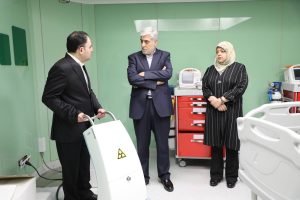
Wearable Technologies in Managing Chronic Diseases
Barekat Health & Pharmaceutical Group: In recent decades, significant advancements in technology, particularly in digital health, have provided new solutions for managing chronic diseases. Chronic conditions such as diabetes, hypertension, and cardiovascular diseases represent major challenges for healthcare systems worldwide.
These diseases impose substantial burdens on patients and healthcare systems due to the need for continuous monitoring and precise management. In this context, wearable technologies, including smartwatches, health bracelets, and biometric sensors, are crucial for improving patients’ quality of life and reducing treatment costs.
History & Evolution of Wearable Technologies
Wearable technologies initially emerged as tools for monitoring physical activity and fitness. However, with advancements in science and technology, these devices have evolved into powerful tools for managing chronic diseases.
The first generation of these technologies primarily included simple devices such as pedometers and heart rate monitors that provided basic information about physical activity and general health. Over time, advancements in sensors, microelectronics, and artificial intelligence have transformed these devices into more sophisticated and accurate tools capable of providing comprehensive health information.
Wearable Technologies in Managing Chronic Diseases
1. Diabetes Management: Diabetes is one of the most common chronic diseases requiring continuous blood glucose monitoring. Wearable technologies, especially continuous glucose monitoring (CGM) devices, enable diabetic patients to monitor their blood glucose levels in real-time without the need for frequent blood samples.
These devices typically include a small sensor placed under the skin that continuously measures glucose levels in interstitial fluid. The data from these sensors is sent directly to the patient’s smartphone or smartwatch, providing alerts for high or low blood glucose levels. This information also allows physicians to better monitor their patients’ conditions and provide more effective treatments.
2. Blood Pressure Monitoring: High blood pressure is a significant risk factor for cardiovascular diseases and requires continuous monitoring. Smartwatches and health bracelets equipped with optical sensors can measure blood pressure non-invasively.
These sensors use advanced technologies such as phot plethysmography (PPG) and complex algorithms to analyze blood flow changes in the vessels and measure blood pressure. The data obtained from these sensors helps users stay informed about their blood pressure status and make necessary lifestyle or medication adjustments.
Benefits of Using Wearable Technologies
Using wearable technologies in managing chronic diseases offers numerous advantages, including improved quality of life, reduced healthcare costs, increased patient independence, and better access to healthcare services.
1. Improved Quality of Life: Wearable technologies allow patients to monitor their health status in real-time without frequent visits to healthcare facilities. This capability reduces stress and increases patients’ confidence in managing their conditions. For example, diabetic patients using CGM devices can easily stay informed about their blood glucose fluctuations and take appropriate actions.
2. Reduced Healthcare Costs: Continuous health monitoring through wearable technologies can lead to reduced healthcare costs. These technologies enable physicians to monitor patients’ conditions more precisely and prevent serious complications. Additionally, the use of these technologies can decrease the need for frequent visits to healthcare facilities and costly tests.
3. Increased Patient Independence: A major challenge for patient s with chronic diseases is reliance on others for disease management. Wearable technologies provide precise and real-time information, allowing patients to manage their conditions more independently. This independence not only improves patients’ morale but also has positive psychological effects.
Challenges and Limitations
Despite their numerous benefits, wearable technologies in managing chronic diseases face several challenges and limitations, including data accuracy and reliability, privacy concerns, high costs, and public acceptance.
1. Data Accuracy and Reliability: One of the critical issues with wearable technologies is the accuracy and reliability of the data collected. Although these devices have advanced significantly, measurement errors can still occur. For example, optical sensors may be affected by factors such as body movement, ambient light, or skin condition, leading to inaccurate information. Therefore, the use of these devices should be accompanied by medical consultation and be part of a comprehensive treatment plan.
2. Privacy Concerns: Collecting and transmitting biometric data through wearable devices raises privacy issues. Health information is highly sensitive and must be protected to prevent unauthorized access and potential misuse. Manufacturers of these devices should employ advanced encryption methods and appropriate security policies to safeguard user information.
3. High Costs: The cost of wearable devices remains a significant challenge. Although prices have decreased over time, many patients may still find these technologies expensive. This issue is particularly prominent in developing countries and low-income communities where the burden of healthcare costs often falls on the patients themselves.
4. Public Acceptance: Public acceptance of wearable technologies for managing chronic diseases is another important challenge. Many patients may be reluctant to use these devices due to lack of awareness or concerns about their complexity. Educational and awareness programs are needed to help patients and the general public benefit from these technologies.
Wearable technologies & monitoring other chronic diseases
Beyond diabetes and hypertension, wearable technologies also play an effective role in managing and monitoring other chronic diseases. These devices have applications in areas such as cardiovascular diseases, respiratory diseases, and sleep disorders.
1. Cardiovascular Disease Management: Cardiovascular diseases are a leading cause of death globally. Wearable technologies are particularly effective in monitoring vital signs related to heart health, such as heart rate and electrocardiograms (ECG). Wearable devices equipped with ECG sensors can help patients and physicians diagnose and manage cardiovascular diseases. These devices can detect arrhythmias or irregular heartbeats and alert users to seek timely medical intervention.
2. Respiratory Disease Monitoring: Chronic respiratory diseases, such as asthma and chronic obstructive pulmonary disease (COPD), also require careful monitoring. New wearable technologies using respiratory sensors and oximeters can measure blood oxygen levels and monitor patients’ breathing patterns. This information helps patients detect symptoms early and prevent acute attacks. For instance, a COPD patient can continuously measure their blood oxygen levels with a wearable device and take necessary actions, such as using an oxygen concentrator, if levels drop.
3. Sleep Disorder Monitoring and Management: Sleep disorders significantly impact overall health and can lead to other chronic conditions like hypertension and cardiovascular diseases. Wearable technologies, such as sleep bracelets, use motion and heart rate sensors to analyze users’ sleep patterns and provide detailed information about sleep quality. These devices can detect issues like sleep apnea or insomnia and help users manage their sleep problems through health recommendations or medical consultations.
AI & Data Analytics in Enhancing Wearable Technology Performance
One of the key innovations improving wearable technology performance is the use of artificial intelligence (AI) and data analytics for analyzing collected data. The vast amounts of biometric data gathered by wearable devices can be analyzed and transformed into valuable insights using AI algorithms.
1. Personalized Healthcare: AI enables personalized healthcare for each patient. AI algorithms can identify specific patterns in the collected data and provide tailored health recommendations. For example, an intelligent system might detect that a diabetic patient is sensitive to certain blood glucose patterns and suggest appropriate dietary or medication adjustments.
2. Predicting and Preventing Diseases: AI can predict the likelihood of diseases or complications by analyzing past data. This capability allows physicians and patients to take preventive measures and avoid serious issues. For instance, a wearable device can analyze heart rate and physical activity data to predict the risk of a heart attack and alert the user to consult a physician.
Integration with Healthcare Systems
Wearable technologies are most effective in managing chronic diseases when integrated with healthcare systems and hospital information systems (HIS). This integration allows physicians to continuously access patient data and provide personalized and timely care.
1. Real-Time Data Exchange: Integrating wearable technologies with healthcare systems enables real-time data exchange among patients, physicians, and healthcare facilities. This exchange helps physicians make timely decisions and adjust treatment plans as needed. For example, if a wearable device reports a sudden increase in a patient’s blood pressure, the physician can immediately recommend actions or prescribe new medication.
2. Improved Care Coordination: Integration enhances coordination among physicians and other healthcare providers. This is especially important for patients with complex chronic diseases requiring multi-faceted care. Access to comprehensive and up-to-date patient information allows medical teams to provide more coordinated treatments and avoid medication conflicts or treatment inconsistencies.
Wearable Technologies in Chronic Disease Management
Given the rapid advancements in wearable technology and the growing demand for digital health solutions, the role of these technologies in managing chronic diseases is expected to become more prominent. Developing wearable devices with higher accuracy, lower costs, and enhanced capabilities can improve patients’ quality of life and reduce financial burdens on healthcare systems. Additionally, the use of AI and machine learning in analyzing data from these devices is anticipated to enhance disease prediction and prevention.
Conclusion
Wearable technologies play a crucial role in managing chronic diseases. By providing continuous monitoring of vital signs and offering precise information for patients and healthcare providers, these technologies not only enhance patients’ quality of life but also contribute to reduced treatment costs and improved outcomes. With further advancements in AI and data analytics, these technologies are expected to become increasingly effective and efficient, playing a vital role in the future of healthcare.
-
Barkat Group specialized meeting

-
Safa Appointed as Barekat General Director

-
Barekat Health & Pharmaceutical Group at the 10th Iran Pharma Exhibition

-
Ali Safa visits Sobhan Oncology & Sobhan Darou

-
Pirsalehi & Safa visit Saman Daroo 8 Knowledge-based Company

-
Barekat Managing Director Visits Samen Pharmaceutical Company

-
Honoring Pharmacists’ Day

-
Barekat Top Executives Visiting to Barekat Hospital

